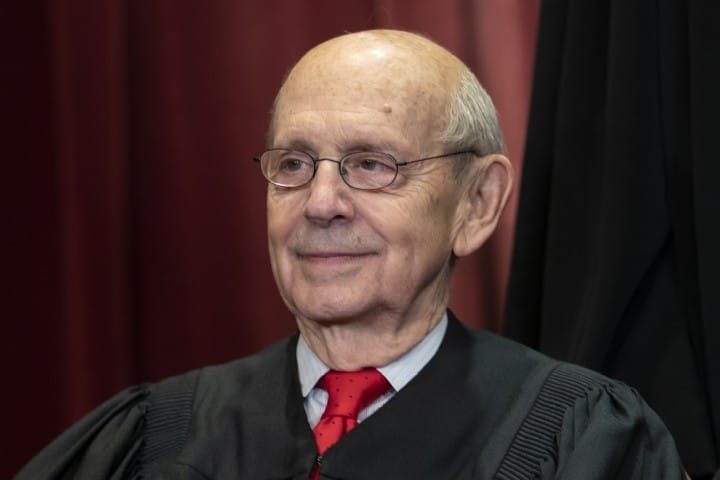
Presuming that former Vice President Joe Biden is going to be sworn into office on January 20 of next year, many Democrats are suggesting that long-serving Supreme Court Justice Stephen Breyer (shown) should retire, so a Democrat president, rather than a Republican president, can nominate his successor. Breyer, however, is not giving any indication that he is going to do so, at least not anytime soon. Breyer is 82 years old, by far the oldest member of the Supreme Court, having been picked by President Bill Clinton in 1994. Clarence Thomas has served longer, but is about a decade younger.
“I enjoy what I’m doing,” Breyer said in October at the Edward M. Kennedy Institute. “Eventually I’ll retire, sure I will,” Breyer said in another interview with Slate. But he added that it was “hard to know exactly when.”
Democrats are concerned that Breyer will continue in his office, as federal judges have no term limits, then die while a Republican occupies the office of president. The late Justice Ruth Bader Ginsburg refused the urgings of Democrats to retire while Barack Obama was president, despite several bouts with cancer, and then finally succumbed to pancreatic cancer in September. That allowed President Donald Trump to nominate Amy Coney Barrett to replace her.
Another reason that Democrats would like to see Breyer replaced by a Democrat president is his opposition to the court-packing schemes supported by many Democrats. Court-packing is the idea that a Democrat president and a Democrat-controlled Senate could simply add more justices to the Supreme Court, beyond the existing nine. While the Constitution does not specify a number on the Court, it has been nine since 1869. When President Franklin Roosevelt, disenchanted with some decisions of the Court, asked Congress to increase the Court’s membership to 15 in 1937 — thus allowing him to nominate six new members more to his liking — his scheme was soundly rejected, despite his Democratic Party having overwhelming control of the Senate.
“I think nine is fine,” Breyer said recently.
Breyer is also opposed to term limits for the Supreme Court — at least anything shorter than 18 years. He expressed concern that shorter term limits could lead to justices job-hunting, even while still on the Court. Three Democratic members of the House of Representatives offered a bill following the death of Ginsburg, called the Supreme Court Term Limits and Regular Appointments Act. The bill proposes that regular appointments to the Supreme Court be made every two years, with new justices serving for a total of 18 years. The bill exempts the current justices on the Court.
Regardless of the merits of the proposal, it is clearly unconstitutional, as the Constitution, in Article III, sets the terms of all federal judges as for life, during “good behavior.” In other words, any federal judge could be removed via the impeachment process, but otherwise serves for life, or until the judge opts to retire. Any change to this constitutional provision could only be accomplished by an amendment to the Constitution, not by a normal statute passed by Congress. The bill’s Democratic Party sponsors — Ro Khanna of California, Don Beyer of Virginia, and Joe Kennedy III of Massachusetts — must have a low regard for the Constitution if they think that they can accomplish something by legislation that actually requires an amendment to the Constitution.
Gabe Roth, speaking for the organization Fix the Court, which advocates for term limits for the Supreme Court, praised the bill, however. “Regular appointments can reduce the contentiousness of nominations and result in a bench that’s still independent and courter-majoritarian.”
The “contentiousness” of nominations to the Supreme Court are because the Supreme Court, over the last few years especially, has gone far beyond the role envisioned for it by the Founding Fathers. Whereas all law is to be made by Congress (Article I of the Constitution), the Supreme Court often has taken upon itself to essentially make law. But Supreme Court decisions are not “the law of the land.” The law of the land is the Constitution of the United States and any acts of Congress that are within its constitutional authority to make. In contrast, court decisions are the law of the case. They are binding upon the litigants, for sure, but governmental policy is to be made by the legislative branch, rather than the judicial branch.
Justices of the Supreme Court are bound to follow the Constitution, not change it. As such, they certainly have the constitutional role to interpret the Constitution’s meaning in making its application to a case before them. They do not, however, have a monopoly on the duty to interpret the Constitution. Members of Congress and the president — indeed, all government officials — take an oath to follow the Constitution, just like members of the judicial branch. This necessitates that they interpret and apply the Constitution in the course of their jobs.
When George W. Bush was president of the United States, he signed the McCain-Feingold bill on campaign finance, although he expressed the view that portions of it were unconstitutional. Rather than veto the bill, as his oath of office required him to do, he signed the bill anyway, arguing that it was up to the Supreme Court to rule on its constitutionality. Such a statement would have horrified the Framers of the Constitution.
If the Supreme Court stuck to its job, vacancies in its membership would not cause so much contention. But when justices take upon themselves to be legislators, rather than judges, as was the case in the Dred Scott decision of 1857, or Roe v. Wade in 1973, it is of no surprise that justices such as Ginsburg and Breyer are urged to retire, rather than die in office, leaving the president of the other party to pick their successor.
It is indeed a sad commentary on just how far we have gone away from the design of the Founding Fathers.



